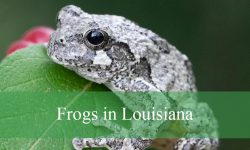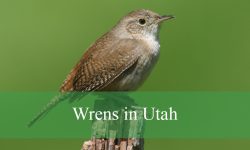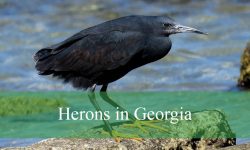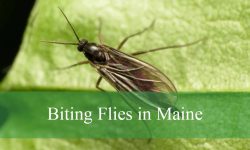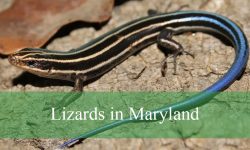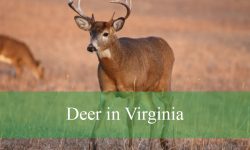Florida has many different types of frogs, from small chorus frogs to large bullfrogs. These amphibians are important for the environment because they eat insects and serve as food for other animals.
Frogs in Florida live in ponds, swamps, marshes, forests, and even gardens. Many are most active at night and during the rainy season, and you can hear their calls filling the air.
Learning to identify frogs can make outdoor trips more interesting. By knowing their colors, patterns, and calls, you can spot these 15 frog species across the state.
Different Types of Frogs Found in Florida
American Green Tree Frog (Hyla cinerea)
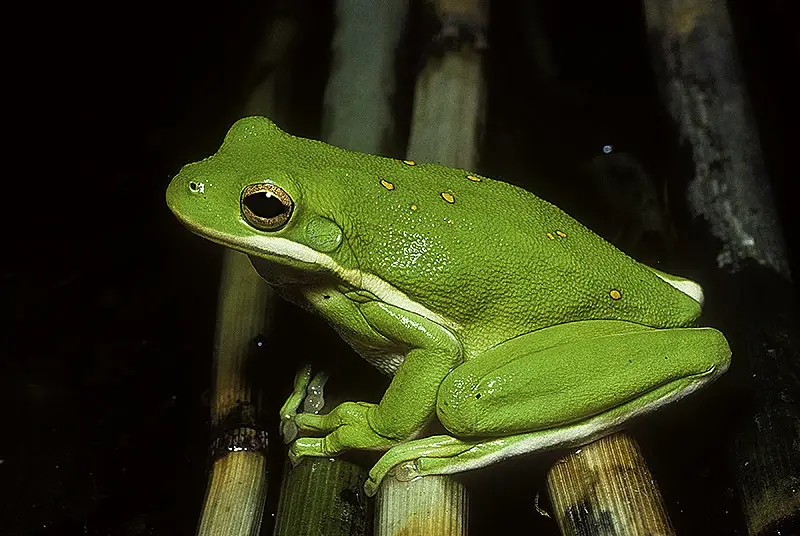
The American Green Tree Frog is one of the most recognizable frogs in Florida, thanks to its smooth bright green skin and slender body. These frogs usually measure between 1.5 and 2.5 inches in length, making them a small to medium-sized tree frog. They have long legs and sticky toe pads that allow them to cling to leaves, stems, and even window screens in suburban areas. A distinct white or yellow stripe often runs along each side of their body.
This species is most active at night when humidity is high, spending the day resting on vegetation. Green Tree Frogs are excellent climbers and prefer habitats with abundant moisture, such as swamps, marshes, and wetlands. Their diet mainly consists of small insects, which they catch with their sticky tongues.
The call of the American Green Tree Frog is a distinctive nasal “quank-quank-quank” that can be heard during the breeding season, especially after heavy rains. These frogs are important contributors to the ecosystem by controlling insect populations and serving as prey for birds, snakes, and larger amphibians.
They are native to Florida and thrive in USDA hardiness zones 7 through 11. Because they adapt well to suburban gardens, they are often spotted near porches, gardens, and artificial ponds where insects are abundant.
Cuban Tree Frog (Osteopilus septentrionalis)
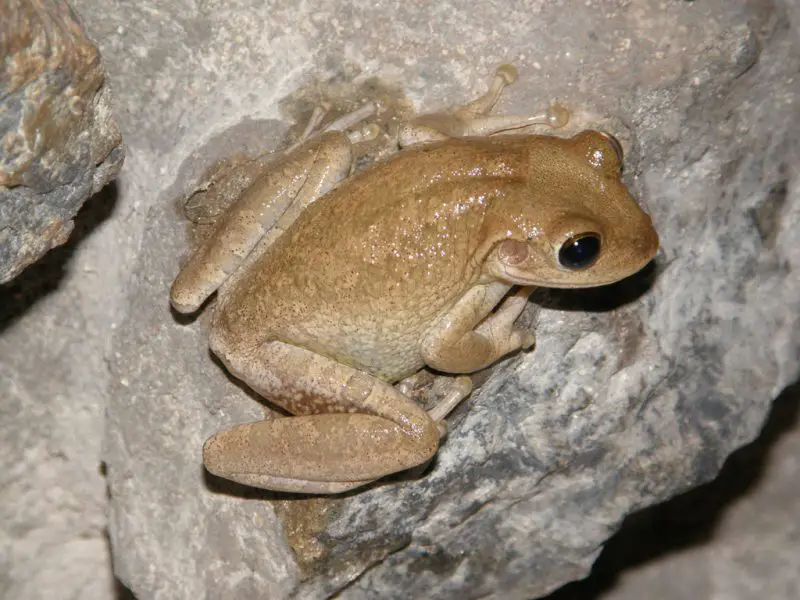
The Cuban Tree Frog is Florida’s largest tree frog and an invasive species introduced from the Caribbean. Adults can grow up to 6 inches long, with bumpy skin that varies in color from gray and brown to green. Their most distinctive feature is their large size compared to native frogs, along with noticeably large toe pads that help them climb smooth surfaces.
This species has become a serious ecological concern in Florida. Cuban Tree Frogs prey on native frogs, lizards, and even small snakes, reducing biodiversity in local ecosystems. They also produce a sticky skin secretion that can irritate human skin and eyes, making them unpleasant to handle.
Cuban Tree Frogs are commonly found in urban and suburban areas, including around homes, gardens, and swimming pools. They are nocturnal and frequently gather near outdoor lights to feed on insects attracted to the glow. Their breeding season peaks during warm, rainy months, when they lay large clutches of eggs in temporary water sources.
These frogs are established throughout most of peninsular Florida and thrive in USDA zones 9 through 11. Wildlife officials recommend removing them when possible to protect native frog species from decline.
Squirrel Tree Frog (Hyla squirella)
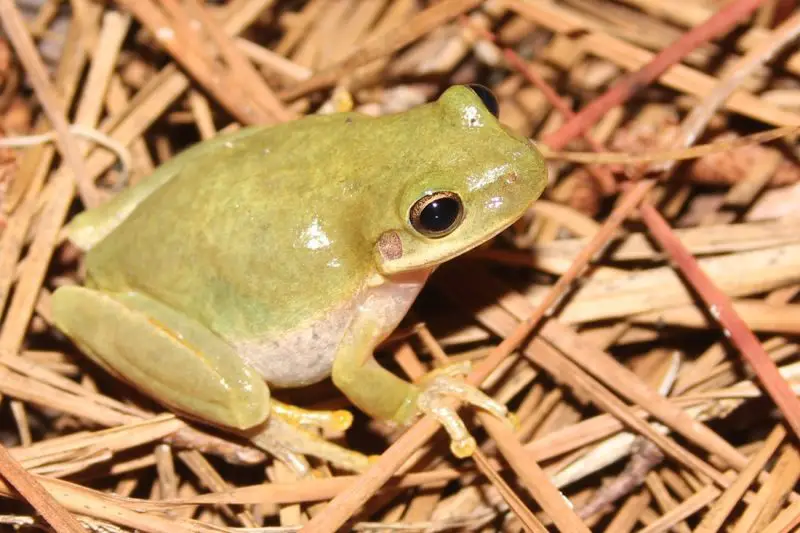
The Squirrel Tree Frog is a small species, usually measuring only 1 to 1.5 inches long. Their coloration is highly variable, ranging from green to brown or even yellowish, sometimes with small dark spots. Because of their ability to change colors depending on temperature, mood, or environment, they are often mistaken for other tree frog species.
These frogs are named after their high-pitched call, which resembles the chattering sound of a squirrel. The call is especially noticeable during rainy weather and breeding season. They are active both day and night, feeding on ants, beetles, flies, and other small insects.
Squirrel Tree Frogs are commonly found in Florida’s woodlands, marshes, gardens, and even city neighborhoods. They often appear on windows, walls, and porches at night where insects gather under artificial lights. Despite their small size, they are tough survivors and can adapt well to human-modified habitats.
Native to Florida, they are widespread across the state and can be found in USDA hardiness zones 7 through 11. Their abundance and adaptability make them one of the most frequently encountered frogs in the region.
Pine Woods Tree Frog (Hyla femoralis)
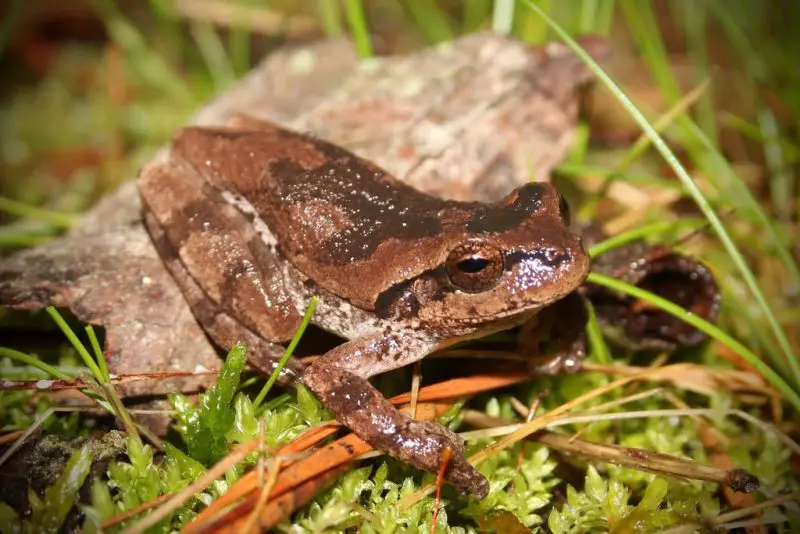
The Pine Woods Tree Frog is a medium-sized species that grows between 1 and 1.5 inches in length. Its coloration varies from gray to brown or reddish, often blending well with tree bark and pine needles. A distinctive feature is the presence of tiny orange or yellow spots on the inside of their thighs, which are visible when the frog jumps.
These frogs are most active at night, using their climbing ability to hunt insects in the trees and shrubs of pine forests. Their call is a series of rapid “machine-gun-like” clicks, which can easily distinguish them from other tree frogs in the same area.
Pine Woods Tree Frogs are found in forests, swamps, and wetlands across Florida. They are especially common in pine flatwoods, as their name suggests, but they also adapt to suburban landscapes with sufficient vegetation and moisture. Their breeding occurs in shallow pools of water during the rainy season.
They are a native species to Florida and thrive in USDA zones 7 through 10. Because of their camouflage and small size, they are often overlooked, but their calls are a clear indicator of their presence.
Barking Tree Frog (Hyla gratiosa)
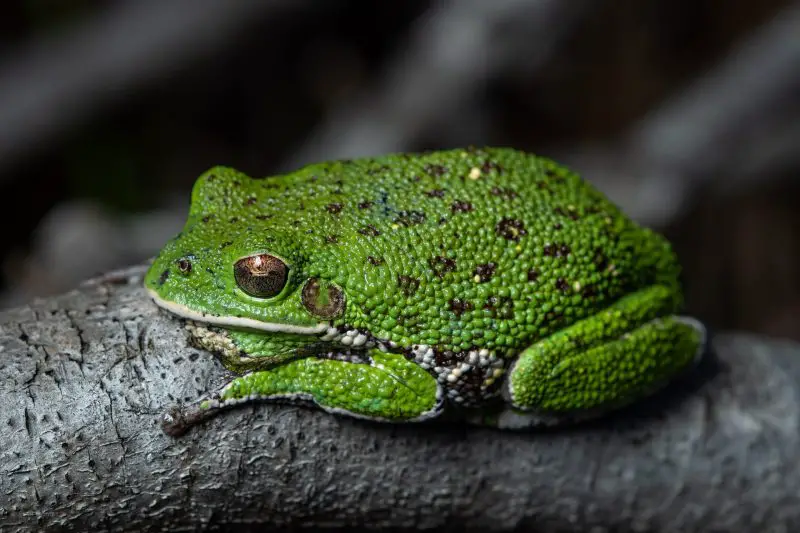
The Barking Tree Frog is the largest native tree frog in Florida, typically reaching 2 to 2.5 inches in length. It has a plump body with rough, warty skin that sets it apart from other tree frogs. Its color ranges from bright green to brown or even purple, often with dark round spots scattered across the back.
As its name suggests, this frog’s call resembles the sound of a dog’s bark, a deep “tonk-tonk-tonk” that can carry across long distances. Males call from ponds and wetlands during the breeding season, especially after heavy summer rains. This vocalization is one of the easiest ways to identify the species in the wild.
Barking Tree Frogs prefer sandy habitats with access to water, such as pine forests, cypress ponds, and river floodplains. They spend much of their time in trees and shrubs but will burrow underground during dry periods to avoid dehydration. Their diet consists mainly of insects, including beetles, crickets, and moths.
They are native to Florida and distributed throughout most of the state, thriving in USDA zones 7 through 10. Because of their size, loud calls, and unique appearance, Barking Tree Frogs are a favorite among wildlife enthusiasts.
Southern Leopard Frog (Lithobates sphenocephalus)
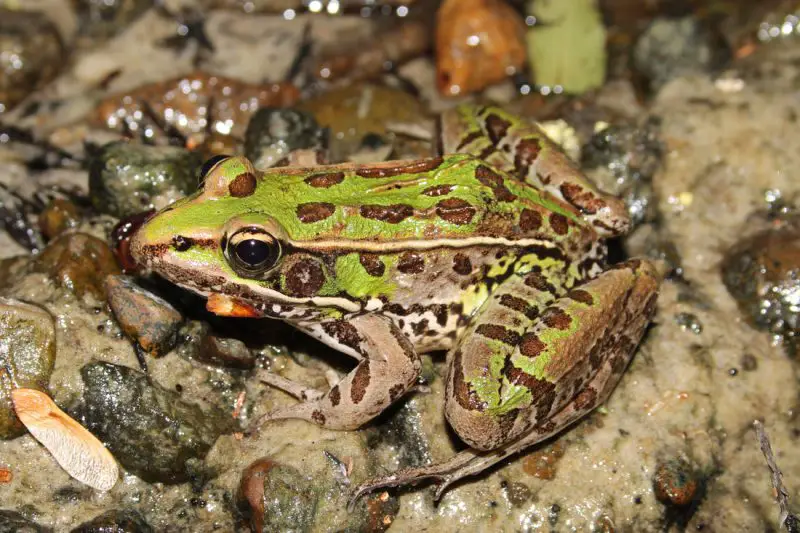
The Southern Leopard Frog is a medium-sized frog, ranging from 2 to 4 inches long, with a slender build and long legs that make it an excellent jumper. Its name comes from the distinct dark spots scattered across its green or brown back, resembling the pattern of a leopard. A pale yellow or whitish stripe usually runs along the upper jaw, which helps distinguish it from similar species.
These frogs are semi-aquatic and often found near ponds, streams, marshes, and roadside ditches. They are strong swimmers and are quick to leap into the water when disturbed. Their diet includes a variety of insects, spiders, and small invertebrates, making them an important part of Florida’s wetland ecosystems.
The call of the Southern Leopard Frog is a chuckling, cackling sound that carries well across wetlands during the breeding season. Breeding typically occurs in the cooler months of late winter and early spring, when males gather in shallow waters to attract females. Large clusters of eggs are laid, which hatch into tadpoles in a few days.
They are native to Florida and are widely distributed across the state. Thriving in USDA hardiness zones 7 through 11, Southern Leopard Frogs are one of the most common ranid frogs in the region and are often seen both day and night.
Pig Frog (Lithobates grylio)
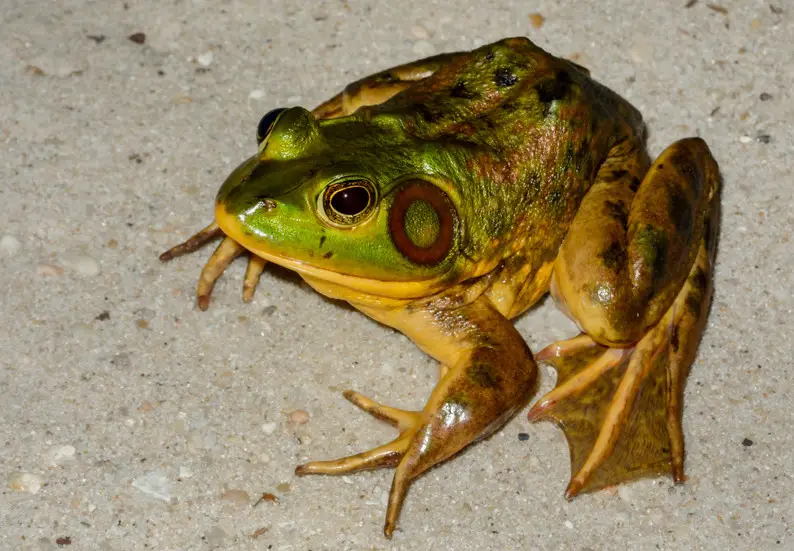
The Pig Frog is one of Florida’s largest frog species, with adults reaching 3.5 to 6 inches in length. They closely resemble the American Bullfrog but can be distinguished by their pointed snouts and the lack of a fold running behind the tympanum (eardrum). Their coloration is usually dark green or brown with irregular blotches, helping them blend into aquatic vegetation.
Pig Frogs are highly aquatic and spend most of their lives in lakes, ponds, marshes, and rivers. They are rarely found far from permanent bodies of water and are strong swimmers with powerful back legs. Their name comes from their distinctive call, which sounds like the grunting of a pig.
These frogs feed primarily on aquatic prey such as crayfish, insects, small fish, and even other frogs. They play an important role in controlling populations of aquatic invertebrates and are themselves preyed upon by wading birds, alligators, and snakes.
Native to Florida, Pig Frogs are widespread across the peninsula and thrive in USDA zones 8 through 11. Because of their large size and deep, pig-like calls, they are often heard in summer nights near lakes and wetlands.
Bronze Frog (Lithobates clamitans clamitans)
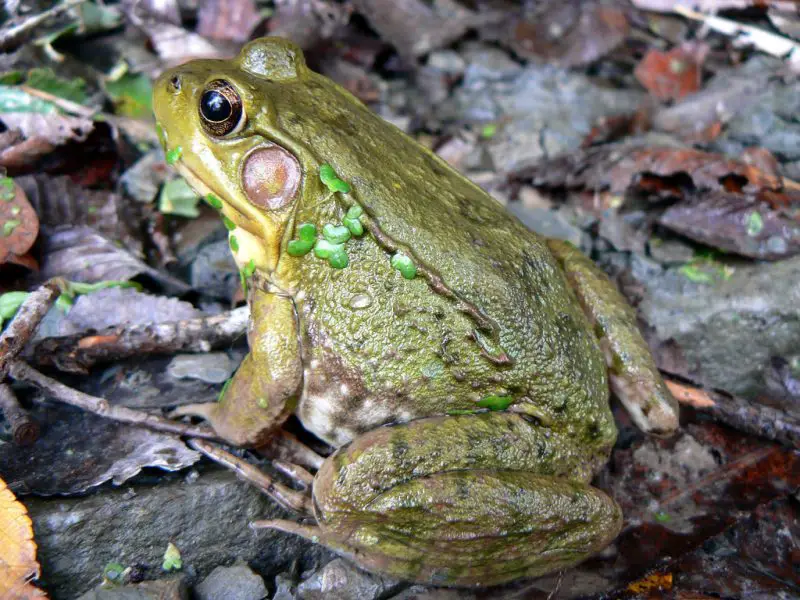
The Bronze Frog is a subspecies of the Green Frog and is named for its distinctive bronze or brownish coloration. Adults typically grow 2 to 4 inches long, with a slender build and prominent ridges running down each side of their back. Their greenish heads and bronzy-brown bodies make them stand out compared to other frogs.
This species prefers habitats near permanent bodies of water, such as streams, rivers, and ponds with dense vegetation. They are strong jumpers and quick to leap into the water when approached. Their diet mainly consists of insects, spiders, and small invertebrates.
The call of the Bronze Frog is often described as sounding like a loose banjo string being plucked—an unmistakable sound during breeding season. Males gather in shallow waters from late spring through summer, calling to attract females and defending territories from rivals.
They are native to Florida’s northern and central regions, particularly in USDA zones 7 through 10. Though not as widely spread as some other frog species, Bronze Frogs remain a stable part of Florida’s wetland communities.
Gopher Frog (Lithobates capito)
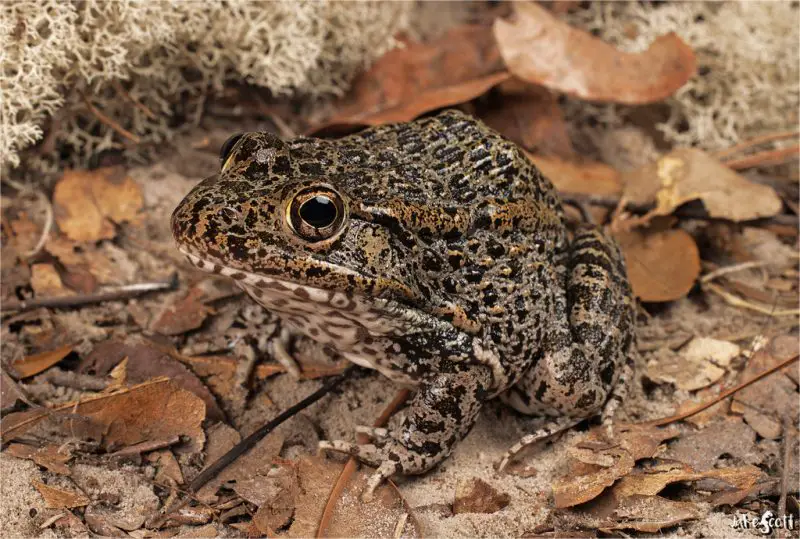
The Gopher Frog is a medium to large frog species, ranging from 2.5 to 4 inches long. They have a stout body with rough, bumpy skin and coloration that varies from gray to tan with dark, irregular spots. Their appearance provides excellent camouflage against sandy soils and leaf litter.
This frog species is closely tied to gopher tortoise burrows, which it uses for shelter during dry periods or extreme temperatures. The burrows provide a cool, moist refuge where the frogs can survive when surface conditions are harsh. This unique relationship is what gives the Gopher Frog its name.
Gopher Frogs are primarily nocturnal and feed on insects, beetles, spiders, and small invertebrates. Their breeding occurs in temporary fishless ponds during the rainy season, when males gather and produce low-pitched calls to attract females.
They are native to Florida, with populations scattered throughout the state, particularly in sandy upland habitats. Found in USDA zones 7 through 10, Gopher Frogs are considered a species of conservation concern due to habitat loss and declining populations.
Florida Bog Frog (Lithobates okaloosae)
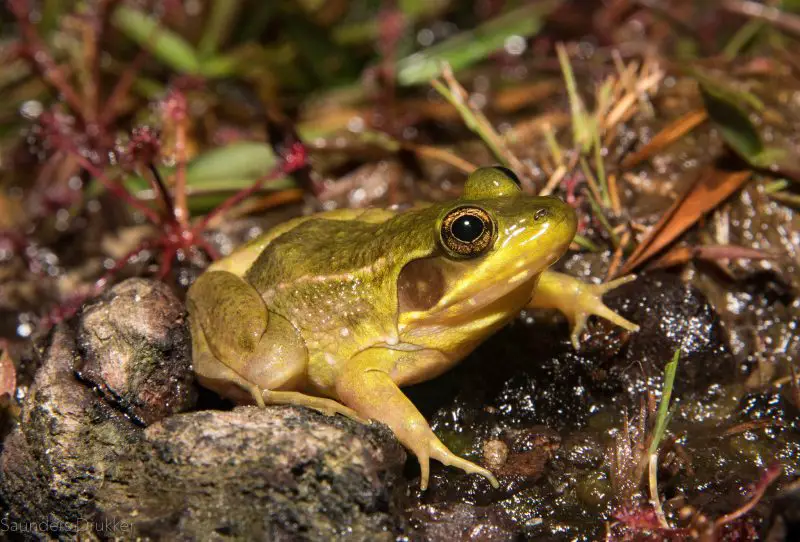
The Florida Bog Frog is one of the rarest frogs in the United States, found only in a small area of the western Florida Panhandle. Adults reach about 2 to 3 inches in length and are generally olive green to brown with faint dark spots. They resemble the Bronze Frog but have a more muted appearance and lack prominent dorsal ridges.
This species lives exclusively in seepage bogs, small streams, and shallow wetlands with clean, flowing water. Their extremely limited range makes them highly vulnerable to habitat changes, pollution, and human disturbance. Because of their restricted distribution, they are listed as a threatened species.
Florida Bog Frogs are primarily nocturnal and feed on small invertebrates such as insects, spiders, and worms. Their call is a distinctive series of short chuckling sounds, usually heard during the spring and summer breeding season.
Endemic to Florida, they occur only in a few counties and are restricted to USDA hardiness zone 8. Conservation programs are in place to protect their fragile habitats, as their survival depends on clean, undisturbed wetland ecosystems.
Little Grass Frog (Pseudacris ocularis)
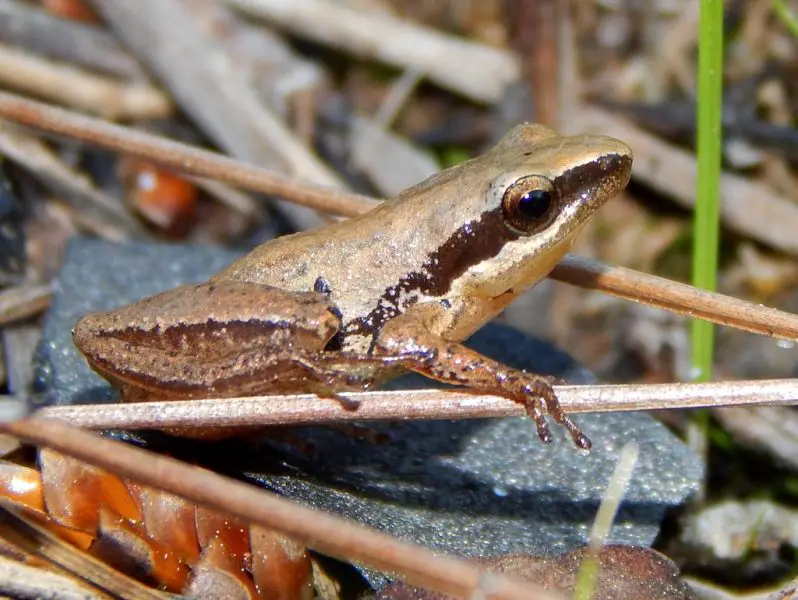
The Little Grass Frog holds the title of the smallest frog in North America, rarely exceeding half an inch in length. Despite its tiny size, it has long, slender legs that allow it to leap several times its own body length. Its coloration ranges from light brown to reddish with a dark stripe running through the eye, providing excellent camouflage among grasses and pine needles.
These frogs inhabit grassy wetlands, pine flatwoods, and bogs, where they remain hidden in dense vegetation. They are rarely seen due to their small size but are often heard during the breeding season when males produce high-pitched, insect-like calls.
The diet of the Little Grass Frog consists mainly of extremely small insects, mites, and other tiny invertebrates. Their delicate size restricts them to feeding on prey that larger frogs typically overlook. They are an important part of Florida’s food chain, serving as prey for birds, snakes, and spiders.
Native to the southeastern United States, they are widespread in Florida and thrive in USDA zones 7 through 11. Their abundance, combined with their small size, makes them an essential but often overlooked component of wetland ecosystems.
Spring Peeper (Pseudacris crucifer)
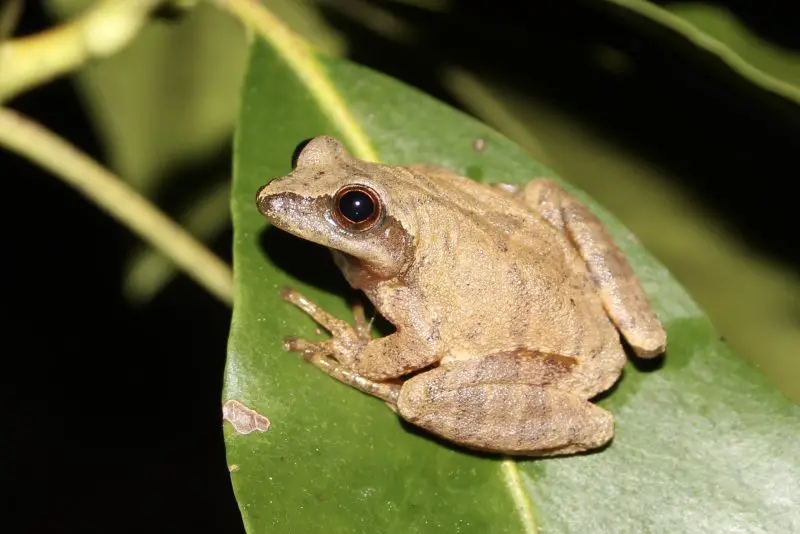
The Spring Peeper is a small chorus frog that reaches about 1 inch in length. It is usually tan, brown, or gray with a distinctive dark “X” pattern across its back, which makes it easy to identify. Their compact body and sticky toe pads allow them to climb low vegetation, though they are more terrestrial than many other tree frogs.
As their name suggests, Spring Peepers are among the earliest frogs to begin calling in late winter and early spring. Their clear, high-pitched “peep-peep-peep” calls can be heard in unison, sometimes creating a deafening chorus near ponds and marshes. These calls are one of the surest signs of the changing season in Florida’s wetlands.
They are commonly found in wooded swamps, marshes, and floodplains, where they breed in shallow water. Outside of the breeding season, they spend most of their time hidden under logs, leaf litter, and vegetation.
Spring Peepers are native to Florida’s northern regions and thrive in USDA hardiness zones 7 through 9. Though small, they play a significant ecological role by consuming insects and providing food for larger predators.
Southern Chorus Frog (Pseudacris nigrita)
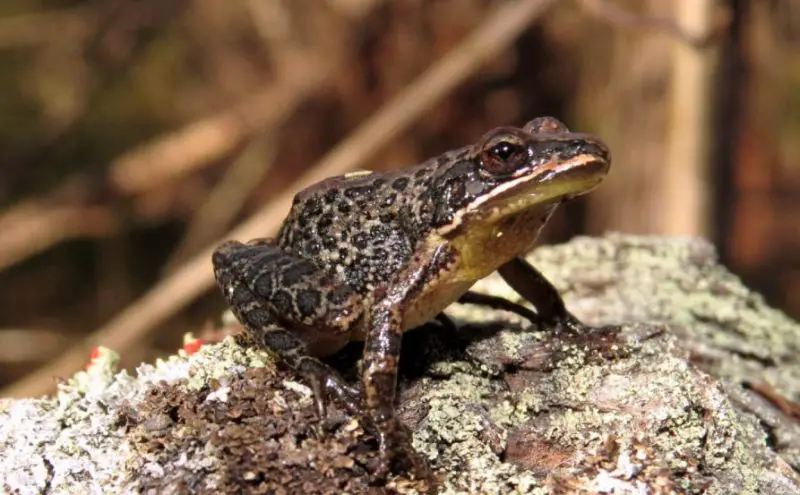
The Southern Chorus Frog is a small species, typically 1 to 1.5 inches long, with a slender build and smooth skin. Its coloration varies from gray to light brown, often with faint stripes running along its back. A dark line through the eye and down the side of the body helps with camouflage in grassy and sandy habitats.
This frog is best known for its call, a rapid series of sharp “crrreek-crrreek” notes that resemble the sound of rubbing a finger across a small comb. The chorus begins in late winter and early spring, often before other frog species start breeding.
Southern Chorus Frogs are found in grassy fields, pine flatwoods, wetlands, and shallow ponds. They breed in temporary pools formed by seasonal rains, laying eggs that quickly develop into tadpoles before the water dries.
They are native to Florida and occur mostly in the northern and central parts of the state. Thriving in USDA zones 7 through 9, they are a common but often overlooked frog due to their secretive habits and small size.
Ornate Chorus Frog (Pseudacris ornata)
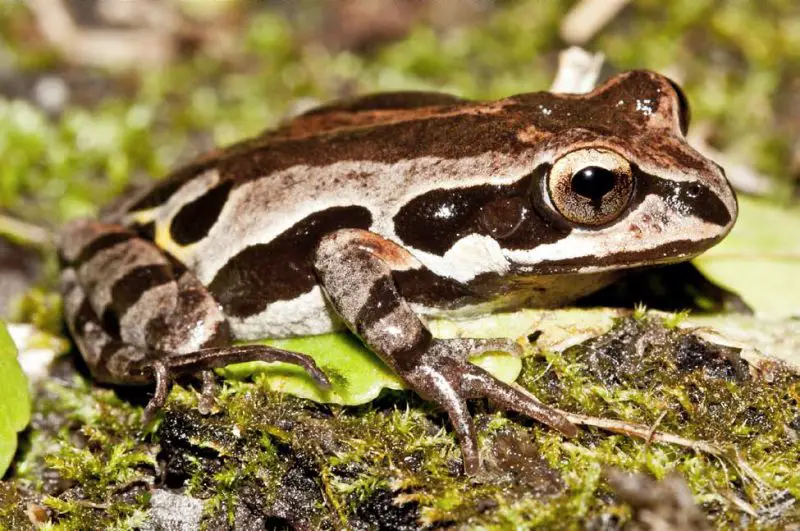
The Ornate Chorus Frog is a strikingly patterned species, reaching about 1.5 inches in length. Their coloration can be gray, brown, or green with bold dark spots and markings across the body. A prominent dark mask runs through the eyes, and the inner thighs may show bright orange or yellow coloration.
These frogs are most active in winter and early spring, making them one of the few frog species that breed during the colder months. Their call is a sharp, metallic “tink-tink-tink” that often rings out in chorus from shallow wetlands and temporary pools.
They inhabit pine flatwoods, sandy fields, bogs, and floodplain forests, preferring areas with sandy soil for burrowing. Outside of the breeding season, Ornate Chorus Frogs remain underground in burrows to avoid predators and extreme weather conditions.
Native to the southeastern United States, they occur in scattered populations in northern Florida and thrive in USDA zones 7 through 9. Their unique appearance and winter-breeding habits make them a fascinating species for naturalists to study.
Eastern Narrow-mouthed Toad (Gastrophryne carolinensis)
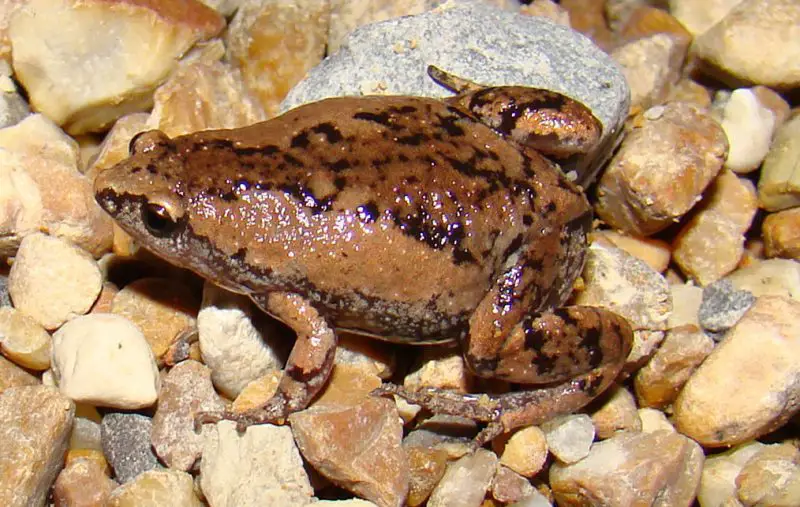
Despite its name, the Eastern Narrow-mouthed Toad is actually a small frog, growing about 1 to 1.5 inches in length. It has a squat, rounded body with a pointed snout and smooth skin that is usually gray, brown, or reddish. Its narrow mouth is specially adapted for feeding on small insects, especially ants.
These frogs are secretive and spend most of their time hidden under logs, leaf litter, and debris. They are more terrestrial than many other Florida frogs and rely on moist habitats to prevent dehydration. Their call is a long, nasal “whee-ee-ee” that can sound like a bleating sheep.
Eastern Narrow-mouthed Toads breed in shallow ponds, ditches, and flooded fields during rainy periods. They lay large clusters of eggs that hatch quickly into tadpoles, which metamorphose into froglets within a few weeks.
They are widespread across Florida, from northern to southern regions, and thrive in USDA zones 7 through 11. Their specialized diet and adaptability make them one of the most resilient frog species in the state.
Best Time and Places to Observe Frogs in Florida
Best Time to Observe
The best time to observe frogs in Florida is during the rainy season and warm months, typically from late spring through summer (May to August). Many species, including chorus frogs and tree frogs, become most active at night when humidity is high. Evening and nighttime hours are ideal because frogs are nocturnal and emerge to feed, call, and breed.
Ideal Habitats
Florida frogs can be found in a variety of habitats depending on the species. Tree frogs such as the American Green Tree Frog and Cuban Tree Frog are commonly spotted in wooded areas, near ponds, or even in suburban gardens. True frogs, including Bullfrogs and Green Frogs, prefer permanent water bodies like lakes, ponds, rivers, and swamps. Chorus frogs and the Little Grass Frog inhabit grassy wetlands, pine flatwoods, and temporary pools.
Seasonal Activity Patterns
Some species, like the Spring Peeper and Ornate Chorus Frog, are early breeders and can be heard calling in late winter and early spring. In contrast, larger species such as the Pig Frog and American Bullfrog breed in mid to late summer. Rainy nights significantly increase frog activity, making them easier to spot and hear.
Tips for Observation
To maximize your chances of seeing frogs, visit shallow ponds, marshes, and wetlands at night with a flashlight. Listen for distinctive calls to locate species, and move slowly to avoid startling them. Early morning after rainfall is also a good time, as some frogs remain close to breeding pools. Avoid handling invasive species like the Cuban Tree Frog, which can irritate skin.
FAQs about Florida Frogs
What is the most common frog in Florida?
The American Green Tree Frog is one of the most common and easily observed species in Florida. It adapts well to both natural and suburban habitats and is frequently heard calling at night.
When is the best time to hear frog calls in Florida?
Frog calls are most prominent during the rainy season from late spring to summer, especially during warm, humid nights. Early spring is ideal for species like Spring Peepers and Ornate Chorus Frogs.
Where can I see frogs in Florida?
Frogs can be observed in a variety of habitats including ponds, lakes, marshes, pine flatwoods, swamps, and even suburban gardens. Listen for calls to locate them, especially near water bodies at night.
Are any Florida frogs endangered or threatened?
Yes, the Florida Bog Frog is listed as a threatened species due to its extremely limited range in the western Panhandle and dependence on clean, undisturbed seepage bogs. The Gopher Frog is also considered a species of conservation concern.
Can I handle or touch frogs safely?
Most native frogs can be handled with clean, wet hands to prevent harm, but avoid touching invasive species like the Cuban Tree Frog, which secretes skin irritants. Wash hands thoroughly after handling any amphibian.
Why are frogs important to Florida’s ecosystem?
Frogs help control insect populations and serve as prey for birds, snakes, and mammals. Their presence is also an indicator of healthy wetland ecosystems and water quality.

